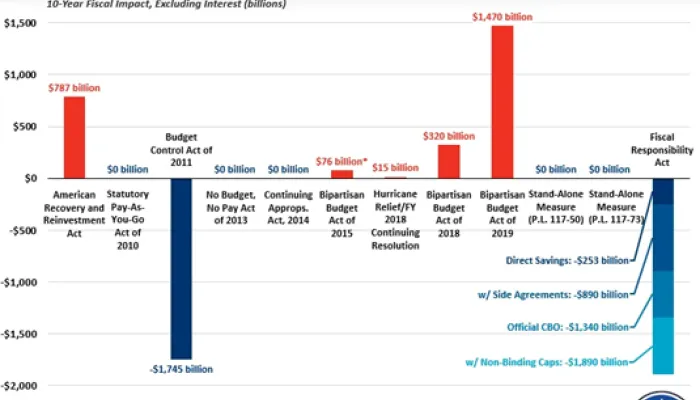Pairing Debt Limit Reform with Budget Goals
A recent bipartisan House letter from 30 Democrats and 30 Republicans requests budget reforms in forthcoming legislation, such as combining debt limit reform with enforceable budget goals. The signatories seek “a process for establishing overall budgetary goals—such as debt-to-GDP targets—that would reduce debt limit brinkmanship as long as the budget remains on a responsible path.”
Instead of establishing budget goals, over the last few years Congress and the President have enacted deficit-increasing legislation, making an unsustainable debt path much worse. The pandemic has added to it, though the response has been largely necessary.
Raising the debt limit provokes disagreement over what it means to be responsible. On the positive side, the debt limit reminds policymakers of our unsustainably rising red ink and debt limit increases have often been combined with budget reforms (see appendix). On the negative side, it enables dangerous brinkmanship that risks default on the federal debt. By the time it must be raised, expenditures in excess of receipts have already been authorized. Further, the debt limit is based on gross nominal debt rather than a more meaningful metric like debt held by the public as a share of the economy.
A middle ground could advance sustainable budgets and reduce default risk. The Committee for a Responsible Federal Budget has called for Congress to establish fiscal targets and to reform the debt limit. This approach could advance both aspects of fiscal responsibility.
Choosing Budget Goals
Congress has three main considerations for fiscal goals: 1) the specific metrics to be targeted, 2) how and when to set them, and 3) how to enforce them.
- Selecting what to target: Goals could be based on debt, deficits, primary deficits, on-budget deficits, or other metrics, either in nominal dollars or as a share of GDP. Targets could focus more on one side of the budget, such as capping spending relative to revenue or putting a floor on revenue relative to spending. Different parts of the budget could have different treatment, such as separate caps for mandatory and discretionary programs, or solvency goals for trust fund programs.
- Options for setting targets: Members of Congress have many timeframe and procedural options. They could enact goals in a single piece of legislation, as in prior budget deals. Instead, budget resolutions could set targets: the Bipartisan Congressional Budget Reform Act (BCoBRA) and the Reforming America’s Fiscal Toolkit (RAFT) Act each proposes that policymakers set targets in the first year of a biennial budget process. Another approach could set overall goals, such as reducing the trajectory of the debt-to-GDP ratio, for each year or each Congress, and subsequent budget resolutions would identify the spending and revenue adjustments needed to achieve the broader goals.
- Enforcing budget goals: Improving the process does not excuse policymakers from having to make decisions. Effective reforms can, however, produce better frameworks for lawmakers to set priorities. The Bipartisan Congressional Budget Reform Act would create a special reconciliation process through which policymakers could choose to reduce deficits. The RAFT Act would have the budget resolution establish a bipartisan joint select committee or a reconciliation process (with a joint select committee backstop) each Congress. Other options could also help facilitate budget goals. Congress could consider a presidential proposal and congressional alternatives for deficit reduction. Certain conditions could trigger expedited consideration of deficit-reducing legislation. Automatic, pre-specified adjustments to both spending and revenue could be enacted to achieve budget savings. Leaders and committee chairs could be held responsible for budget outcomes.
Reforming the Debt Limit
Enforceable budget targets could facilitate useful reforms to the debt limit. The Bipartisan Congressional Budget Reform Act would automatically send legislation to the President to increase the debt ceiling by the amount assumed in the budget resolution. That way, adopting and following through on a budget resolution would settle the debt limit until the next budget resolution is due. Though recent budget resolutions have tended to be partisan messaging documents, reform could bring them closer to realistic blueprints for governance.
Beyond BCoBRA, other actions could trigger debt limit adjustments. Meeting budget targets could automatically suspend or increase the debt limit. The president could suspend it, subject to congressional disapproval. Debt-increasing legislation could include a commensurate debt limit increase (a stick). Conversely, enacted savings could increase the debt limit (a carrot). The limit could apply as a percentage of GDP instead of as a nominal amount. Congress could improve the debt limit other ways, too.
***********************************
Though no procedural improvement is a cure-all, budget targets can help reduce debt growth, and debt limit reform can avoid default or at least make it less likely. Combining them could produce better budget and process outcomes. More options are available through our Better Budget Process Initiative and through legislation like the Bipartisan Congressional Budget Reform Act and the Reforming America's Fiscal Toolkit Act.
In the meantime, pandemic response will likely continue—appropriately—to swell near-term deficits. As the crisis recedes and the economy recovers, however, Congress must shift to restoring fiscal responsibility. Pairing debt limit reforms with enforceable budget targets should be a pillar of those efforts.


